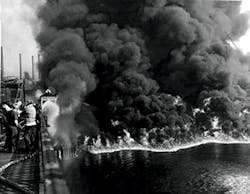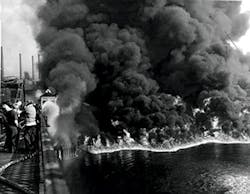By Vanessa Leiby
Most professionals in the water business are aware that December 16, 2014, marks the 40th anniversary of the Safe Drinking Water Act (SDWA). The Federal regulation of drinking water actually extends back even further to 1914, when the U.S. Public Health Service (PHS) first set standards for bacteriological quality of drinking water. Although these standards were revised in 1925, 1946 and 1962, it became abundantly clear in the late 1960s that more needed to be done both for drinking water and clean water.1
As an Ohio native, I grew up with stories of the 1969 Cuyahoga River fire that ultimately contributed to the creation of the Clean Water Act (CWA) and Environmental Protection Agency (EPA). When I was a young child, we would make yearly visits to the Cedar Point amusement park in Sandusky, Ohio, on the shores of Lake Erie. One of my most vivid memories was holding hands with my sisters and running into the water only to be dragged out covered from head to toe in viscous crude oil. Little did I know that these experiences would help shape and form the direction of my higher education.
As a student at Ohio State University in the early to mid-1980s, my undergraduate focus was aquatic ecology, and my master's work was in aquatic toxicology. Over those years, I made numerous trips to Lake Erie and its tributaries, monitoring fish species and characterizing blood parameter changes and carcinogenic effects in fish species exposed to polynuclear aromatic hydrocarbons (PAHs) still present in the muck and mud of Ohio river bottoms.
I joined the Ohio EPA's drinking water program as an air/water quality scientist in 1985, and the rest, as they say, is history. Back then, I had all the regulated contaminants memorized in alphabetical order (our regulations were maybe 20 pages long), and you could read through them all in about a half hour and feel as though you had a fairly good grasp of drinking water protection. One only has to begin reading the current Title 40 Part 141 of the Code of Federal Regulations (CFR) or electronic CFR (eCFR)2 to understand how complicated and complex our regulations have become.
As we think back over the last four decades of the SDWA, it is impressive to see how far we have come. The 1996 Amendments, in particular, dramatically expanded the coverage of the SDWA from source to tap and most importantly created a process by which sound science, research and meaningful public health risk reduction helps guide and direct future regulatory efforts.
That being said, I was struck recently by a series of presentations at the Association of State Drinking Water Administrators (ASDWA) Annual Conference in Albuquerque, N.M., on current public health challenges that covered storage tanks, Legionella in premise plumbing and cyanotoxins. What struck me is that these very real, documented public health challenges don't conform to the traditional way of regulating -- mostly one size fits all, monitoring at entry points or specified locations in the distribution system, and calculating quarterly and running annual averages to determine maximum contaminant level (MCL) compliance.
While this is indeed an oversimplification, the reality is that the real public health risks we face today in drinking water just do not conform to the standard ways we have regulated contaminants in the past. While we are chasing the one-in-a-million lifetime risk related to a contaminant detected at parts per billion (ppb), the Centers for Disease Control and Prevention (CDC) estimates that 800 to 1,800 people die each year due to exposure to Legionella. In August of this year, Toledo, Ohio, for example, shut off water to 500,000 people for four days because of cyanotoxins in the drinking water caused by a harmful algal bloom.
Perhaps as we celebrate and reflect on the 40th anniversary of the SDWA, we may also want to think about the next four decades and whether our current regulatory structure is adequate to meet the complexities of future public health protection. For example, the Food and Drug Administration (FDA) and the U.S. Department of Agriculture (USDA) for many years have utilized a Hazard Analysis and Critical Control Points (HACCP) program, an internationally recognized process control system, to systematically protect food from biological, chemical and physical hazards in production processes to ensure product safety and measure and reduce risk. The focus of the program is on the prevention of hazards rather than finished product inspection.
Over the last few years, a number of researchers in the water industry have started to apply the HACCP system to identifying and reducing hazards at drinking water utilities and to control the finished water quality. In fact, some of the initial research in this area can be traced back to 1994. While the concept can be applied across all water systems, the identification of hazards is system-specific as are the resulting risk reduction and mitigation decisions. Perhaps it is finally time to look at a new drinking water paradigm for public health protection.
About the Author: Vanessa Leiby is the executive director of the Water and Wastewater Equipment Manufacturers Association (WWEMA), located in Washington, D.C. Founded in 1908, WWEMA has been representing the interests of equipment manufacturers to Congress, Federal Agencies and other stakeholders for over 106 years.
References:
1. The U.S. Environmental Protection Agency, 25 Years of the Safe Drinking Water Act: history and Trends, December, 1999, http://permanent.access.gpo.gov/websites/epagov/www.epa.gov/safewater/sdwa/trends.html
2. The U.S. Government Printing Office, Electronic Code of Federal Regulations, Nov. 7, 2014, http://www.ecfr.gov/cgi-bin/text-idx?SID=78c1f424d319fcdcc754727098effcf6&tpl=/ecfrbrowse/Title40/40tab_02.tpl
As we celebrate and reflect on the 40th anniversary of the SDWA, we may also want to think about the next four decades and whether our current regulatory structure is adequate to meet the complexities of future public health protection.
***************
WWEMA announces new 2015 officers, directors; honors 2014 Morriss Award recipient
During its 106th Annual Meeting on Nov. 6-8 in Tucson, Ariz., the Water and Wastewater Equipment Manufacturers Association (WWEMA) announced its new 2015 officers and directors, along with the recipient of the 2014 James C. Morriss Member Achievement Award.
The 2015 WWEMA Executive Committee comprises:
- Chairman Frank Rebori, President - Smith & Loveless Inc. (Lenexa, KS)
- Chairman-Elect Ron Port, VP, Marketing and Business Development - SPX Corporation (Charlotte, NC)
- Vice Chairman Tammy Bernier, President - Duperon Corporation (Saginaw, MI)
- Treasurer Mark Turpin, VP and General Manager - Parkson Corporation (Fort Lauderdale, FL)
- Immediate Past Chairman Chuck Powers, Director, Global Water Resource Industry & Product Management - Flowserve Corporation (Taneytown, MD)
Three members were elected to WWEMA's 2015 board of directors (BOD):
- Andrew Fraher, Director, Marketing and Business Development - Xylem Inc. (Charlotte, NC)
- Louis LeBrun, VP - Pinnacle Ozone Solutions (Cocoa, FL)
- Leelon Scott, Director, OEM Business Development - Revere Control Solutions (Birmingham, AL)
Powers named Bernier as recipient of the 2014 James C. Morriss Member Achievement Award. The award is presented to a WWEMA member each year for significant contributions to the mission of the organization and to the benefit of the water and wastewater industry.
Powers cited Bernier's outstanding service to WWEMA throughout the year, including serving as its treasurer, shepherding the work of a newly formed WWEMA Investment Committee, initiating an exploration of the WWEMA dues structure, and serving as chair of the 2014 Washington Forum.
Bernier has 30 years of management and family business experience. She served as WWEMA treasurer in 2013-2014 and has been elected vice chair for 2014-2015. She also serves on the WWEMA BOD, Saginaw Community Foundation's BOD, Inforum Great Lakes Bay Regional Council, and Child Abuse and Neglect Council of Saginaw County's BOD. She graduated with a bachelor's degree in business management from Saginaw Valley State University.
More WaterWorld Current Issue Articles
More WaterWorld Archives Issue Articles




